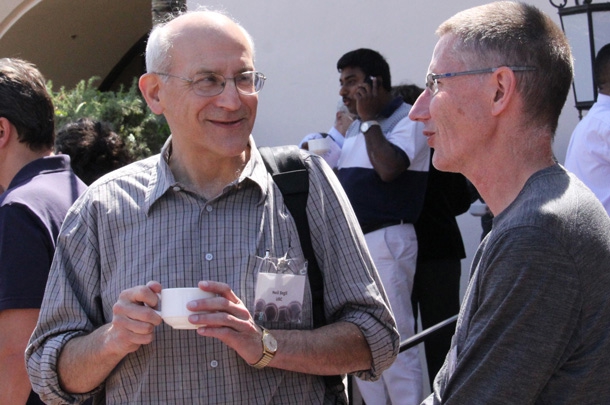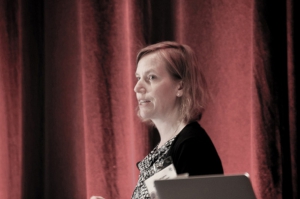Working alone, a scientist or university can only make so much progress in finding answers to basic questions or new treatments for diseases ranging from HIV to cancer to diabetes. That’s why almost 300 scientists from USC, UCLA and UCSF gathered in Santa Barbara for a Tri-institutional Stem Cell Retreat.
Held May 17–19 at the Fess Parker Doubletree Hilton Resort, the retreat showcased some of the most innovative projects from the three universities’ stem cell research centers, all of which were established with support from Eli and Edythe Broad and the California Institute for Regenerative Medicine (CIRM).
“If we want a true measure of success for the meeting, it won’t simply be that we’ve had a good time, but that the scientific interchange between us provides new insights and collaborative opportunities,” said Andy McMahon, PhD, FRS, director of the Eli and Edythe Broad Center for Regenerative Medicine and Stem Cell Research at USC.
Keynote speaker Amy Wagers, PhD, from the Harvard Stem Cell Institute detailed an experiment in which she connected the circulatory systems of an old mouse and a young one. The old mouse experienced youthful benefits, including a decrease in heart enlargement and an increase in the regeneration of muscle, neurons and the insulin-producing beta cells of the pancreas. Conversely, the young mouse suffered ailments of age, including a decrease in the regeneration of muscle, neurons and beta cells. Her goal is to find ways to use some of these youthful blood-borne factors to treat age-related dysfunction.
In all, about 30 principal investigators (PIs), postdoctoral scholars and PhD students discussed advances relevant to a variety of diseases.
The cardiovascular system was the topic of several talks and included USC PI Megan McCain, PhD, who discussed engineering micro-scale mimics of human tissues called “hearts on chips,” which enable scientists to study diseases and screen drugs. USC postdoctoral scholar Michaela Patterson, PhD, presented her hypothesis that multiple genes dictate the number of regenerative cells present in a mammalian heart.
In the neural realm, USC PI Michael Bonaguidi, PhD, highlighted neural stem cells, USC postdoctoral fellow Kate Galloway, PhD, discussed reprogramming skin cells into neurons, and USC postdoctoral fellow Suhasni Gopalakrishnan, PhD, talked about converting skin cells into inner ear sensory cells.
Regarding sensory organs, USC PI David Hinton, MD, summarized plans for a phase 1 clinical trial to treat age-related macular degeneration, the leading cause of blindness in the elderly in the Western world. Built on a partnership with USC colleague Mark Humayun, MD, PhD, and collaborators at UCSB, Caltech and the City of Hope supported by nearly $40 million from CIRM, the trial uses stem cells to produce some of the key cells that help people to see.
Several researchers also shared progress in tackling diseases of the digestive and urinary systems. Tracy Grikscheit, MD, a PI at Children’s Hopital Los Angeles and USC, talked about her work in intestinal regeneration, for example.
Regarding the skeletal system, USC PI Gage Crump, PhD, discussed repairing bone fractures, and USC PI Yang Chai, DDS, PhD, described stem cells that maintain and repair the skull and could potentially be used to treat babies who suffer from fused skull joints, which constrict brain development.
On other topics, USC PI Paula Cannon, PhD, shared progress in developing next-generation tools to genetically edit blood stem cells as a treatment for HIV, immune deficiencies and blood diseases. Cannon and her colleagues have already developed one tool to introduce a gene mutation that confers natural immunity to HIV — an approach that is heading into clinical trials. And USC PI Scott Fraser, PhD, discussed microscopes and imaging tools.
An additional 100 scientists presented their research on posters, with 10 giving brief poster highlight talks.
“I’ve learned so much from this meeting,” said McMahon. “It’s a rapidly moving field, so I think we need a retreat next year as well.”
— Cristy Lytal



